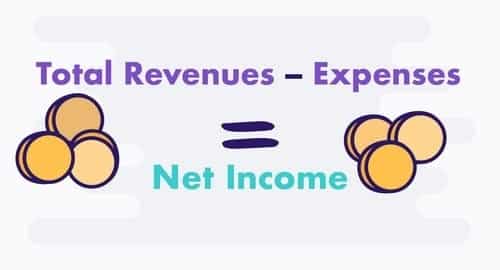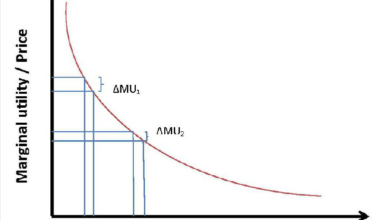To stay in business, your company must earn more money than it spends, at least in the long run. A net income formula indicates whether you are profiting or losing money. This equation, however, only reveals part of the picture; your business may be lucrative, but you may not have any money in the bank. The balance sheet depicts your entire financial condition, which is likely to be good if your net income is consistent. Let us look at the net income on the incone sheet and how to calculate it.
What is Net Income?
Net income is the amount of accounting profit that a company has after deducting all of its expenses. Net income is calculated by deducting sales revenue from COGS, SG&A, depreciation and amortization, interest expenditure, taxes, and other expenses.
The last line item on the income statement is net income. However, some income statements will include a separate part at the bottom that reconciles beginning retained profits with ending retained earnings via net income and dividends.
Net Income, the bottom line of a company’s income statement is known by three different names:
- Profitability
- Profit After net
- Earnings after taxes
All three of these terms mean the same thing, which can be perplexing for those unfamiliar with finance and accounting.
Net Income Example
Here are some examples of net income for a business and an individual.
A Business’s Net Income Example
Let’s take a look at Coca-net Cola’s income to better comprehend it. The corporation, like all publicly traded companies in the United States, declares its sales and expenses to the Securities and Exchange Commission four times a year.
Coca-Cola reported $9.02 billion in revenue for the three months ending April 2, 2021. It also made $66 million in interest payments and $417 million in equity and other income. The cost of products sold was $3.505 billion, which included raw material and direct labor costs, $2.669 billion in general and administrative expenses, $124 million in miscellaneous operating expenses, $442 million in interest payments, and $508 million in taxes.
Coca-net Cola’s income now stands at $2.255 billion. Here’s how it works:
($9.02 billion + $66.6 million + $417 million) − ($3.505 billion + $2.669 billion + $124 million + $442 million + $508 million) = $2.255 billion
An Individual’s Net Income Example
As an example of an individual’s income, suppose Jane receives a bi-monthly paycheck with a gross salary of $3,350. She pays $272.51 in federal taxes, $46.61 in Medicare taxes, $193.31 in Social Security taxes, $102.48 in state taxes, and $125 in insurance premiums. This gives her a NI of:
$3,350 – $272.51 – $46.61 – $193.31 – $102.48 – $125 = $2,610.09 per paycheck or $67,862.34 annually
Why is it Important to understand NI?
Understanding NI is critical because it clarifies how much money may be spent on living expenses as well as discretionary spending.
Here’s an example from business. Assume a business has monthly gross revenue of $2 billion. That may appear to be a relatively robust business in which to invest. However, if the company announces a net loss of $200 million, you’ll likely have a totally different business on the company’s financial health and viability.
NI is significant for an individual because it is the amount that should be considered while spending and creating a budget. After taxes and other payroll deductions, someone earning $4,000 a month may only have $3,000 (or less) to spend. If they spend $4,000 every month, they will swiftly fall into a huge financial hole. Instead, if they look at NI and ensure that scheduled spending is less than NI, they may be able to start saving money for the future.
Net Income Formula
NI is the entire earnings of your company after deducting all business expenses. It is the amount of money available to pay dividends to shareholders, invest in new projects or equipment, pay off debts, or save for future use.
The formula for calculating net income is as follows:
Revenue – Cost of Goods Sold – Expenses = NI
Net Income Formula
The first half of the formula, revenue less cost of goods sold, is also the gross income formula. In other words, the net income formula is:
NI = Gross Income – Expenses
If you really want to keep things simple, you may write the net income formula as:
NI = Total Revenues – Total Expenses
The NI might be either positive or negative. When your company’s revenues exceed its expenses, you have a positive net income. You have a negative net income, also known as a net loss if your entire expenses exceed your total revenues.
Using the formula above, you can calculate your firm’s net income for any business period: annual, quarterly, or monthly—whatever works best for your organization.
An Example of the Net Income Formula
Assume Wyatt’s Saddle Shop wishes to calculate its net income for the first quarter of 2021. Wyatt is working with the following numbers:
- Total earnings: $60,000.
- COGS (cost of goods sold): $20,000
- $6,000 in rent
- $2,000 for utilities
- Payroll is $10,000.
- $1,000 for advertising
- $1,000 in interest charges
To begin, Wyatt may calculate his gross income by totaling his receipts and subtracting COGS:
Gross income = $60,000 – $20,000 = $40,000
Wyatt then totals his costs for the quarter.
Expenses are calculated as $6,000 + $2,000 + $10,000 + $1,000 + $1,000 = $20,000
Wyatt may now calculate his net income by taking his gross income and deducting his expenses:
NI = $40,000 – $20,000 = $20,000
Wyatt’s NI is $20,000 for the quarter.
Operating Net Income Formula
Operating net income is another useful NI figure to keep track of. NI is equivalent to operating net income. However, it examines a company’s profits from operations alone, without accounting for income and expenses that are unrelated to the main activities of the business. Income tax, interest expense, interest income, and profits or losses from the sale of fixed assets are examples of such items.
EBIT, or “earnings before interest and taxes,” is another term for operating income.
The operating net income formula is as follows:
Operating Net Income = NI + Interest Expense + Taxes
Operating Net Income Formula
Or, to put it another way, operating net income can be calculated as follows:
Operating Income = Gross Profit – Operating Expenses – Depreciation – Amortization
Operating net income is sometimes preferred by investors and lenders over NI. This provides them with a better understanding of the profitability of the company’s primary business activities.
For example, a company’s fundamental operations may be losing money. However, if the company sells a valuable piece of machinery, the profit will be reflected in the company’s NI. That profit may give the impression that the company is doing well while, in fact, it is battling to stay afloat. Operating net income excludes the gain, providing financial statement users with a clearer understanding of the company’s profitability and valuation.
This is data that can be obtained from a cash flow statement.
Example of the Operating Net Income Formula
Let’s head back to Wyatt’s Saddle Shop. Wyatt could simply add back the interest expense to his NI to calculate his operating net income for the first quarter of 2021.
NI of $20,000 plus interest expense of $1,000 equals $21,000 operating net income.
If you keep good records, calculating net income and operating net income is simple. In such an instance, you most likely already have a profit and loss statement or income statement that indicates your net income. Your company’s income statement may even isolate operating net income as a separate line item before calculating NI by adding other income and expenses.
How to Calculate Net Income
To calculate net income, start with gross income — the whole amount of money earned — and then deduct expenses like taxes and interest payments.
Individual NI is the money you really receive from your paycheck each month, as opposed to the gross amount you receive before payroll deductions. Other sources of income, such as Social Security payments, side jobs, or investment income, may supplement your NI.
How to Calculate Net Income for a Business
To calculate a company’s net income, begin with its entire revenue. Subtract the business’s spending and operating costs from this figure to calculate the company’s earnings before taxes. Subtract tax from this figure to get the NI.
NI, like other accounting measures, is vulnerable to manipulation by practices such as aggressive revenue recognition or expense concealment. When making an investment decision based on NI, investors should consider the accuracy of the statistics used to calculate taxable income and net income.
Relationships to Other Financial Statements
NI is critical since it is a central line item on all three financial statements. While it is calculated on the income statement, net profit is also utilized on the balance sheet and cash flow statement.
Net income enters the balance sheet via retained earnings, which is an equity account. The following is the formula for calculating ending retained earnings:
Beginning RE + NI – Dividends = Ending RE
Assuming no dividends are paid, the difference in retained profits across periods should equal the net earnings in those periods. If the financial statements include no mention of dividends, but the change in retained earnings does not equal net profit, it is safe to presume that the difference was paid out in dividends.
Net earnings are used in the cash flow statement to calculate operating cash flows using the indirect technique. The cash flow statement begins with net earnings and adds back any non-cash expenses deducted in the income statement.
The change in net working capital is then added to calculate cash flow from operations.
Profitability and Return on Investment
The net profit margin is also calculated using net earnings. This is a useful metric for determining how lucrative a firm is in percentage terms when compared to its previous self or to other companies.
In the DuPont technique, the net profit margin is also used to decompose return on equity – ROE. The classic DuPont formula divides ROE into three parts:
ROE = Net Profit Margin * Total Asset Turnover * Financial Leverage
This way of analyzing a company’s ROE allows the analyst to determine the company’s operational strategy. A corporation that has a high ROE because of large net profit margins, for example, can be called to use a product differentiation strategy.
Balance Sheet and Net Income
Net income should be reported on the income statement, not the balance sheet. It is the bottom line – the field that summarizes all of your income and expenses, as well as their relationship. Although net income does not appear on the balance sheet, it is a significant factor in determining the information that does.
If your business generates a net income by earning more than it spends over time, it begins to amass cash and non-cash assets, which improves the financial picture depicted on the balance sheet. If your business spends more than it makes and suffers a net loss, you must cover the cost of your expenses without relying on revenue from operations or profit. You will begin to deplete your assets, and your net income on the balance sheet may show that your business owes more than it has.
The Importance of Net Income on the Balance Sheet
A company’s positive NI raises its retained earnings, which are part of the stockholders’ equity. A net loss reduces retained earnings as well as investors’ equity.
The NI of a sole proprietorship will result in an increase in the owner’s capital account, which is part of the owner’s equity. A net loss reduces both the owner’s capital account and the owner’s equity.
Cash Flow vs. Net Income
NI is an accounting metric that does not represent a business’s economic profit or cash flow.
Because net profit includes non-cash expenses such as depreciation, amortization, stock-based compensation, and so on, it is not equal to the amount of cash flow generated by a company during the period.
As a result, financial analysts go to tremendous pains to reverse all accounting standards in order to get at cash flow for evaluating a company.
Gross Profit vs. Net Income
Gross profit and NI are two essential profitability parameters for any business. Gross profit is the income or profit that remains after deducting manufacturing costs from revenue. The amount of income earned from the sale of a company’s goods and services is referred to as revenue. Gross profit informs investors about the amount of profit a firm makes from the production and selling of its goods and services. Gross profit is also known as gross income in some cases.
NI, on the other hand, is the profit that remains after all expenses and costs have been deducted from revenue. NI or net profit assists investors in determining a company’s overall profitability, which shows how well a company has been handled.
Understanding the distinctions between gross profit and NI can assist investors in determining whether a firm is profitable and, if not, where the company is losing money.
Difference Between Gross and Net Income
The ability of a corporation to produce a profit while managing its production and labor costs is measured by gross profit. As a result, by examining sales, production costs, labor costs, and productivity, it is a key statistic in evaluating whether a company’s earnings are increasing or declining. If a corporation reports an increase in revenue, but that increase is more than offset by an increase in production expenses, such as labor, the gross profit for that period will be lower.
For example, if a company hires too few production workers during its peak season, it will have to pay extra overtime to its current employees. As a result, labor expenses would rise and gross profitability would decline. However, utilizing gross profit as an overall profitability gauge is insufficient because it does not account for all of the other costs associated with running a successful business.
NI, on the other hand, indicates the profit from all areas of a company’s business operations. As a result, NI is more inclusive than gross profit and can provide insight into the effectiveness of the management team.
For example, a firm may boost its gross profit while mismanaging its debt by borrowing excessively. Despite the company’s excellent sales and production efforts, the higher interest expense for debt payment could result in a decrease in net income.
Gross Profit and Net Income Limitations
Because it does not apply to all companies and industries, gross profit has limitations. A services company, for example, is unlikely to have production or cost of goods sold costs. Although NI is the most comprehensive indicator of a company’s profitability, it, too, has limitations and can be misleading. For example, if a corporation sold a building, the proceeds from the sale would boost NI for that time. Investors that focus solely on NI may misunderstand the company’s profitability as an increase in sales of its goods and services.
Operating Profit, Gross Profit, and Net Income
It should be noted that gross profit and NI are only two of the profitability metrics available to determine how well a company is operating. Operating profit, for example, is a company’s profit before interest and taxes are subtracted, which is why it’s also known as EBIT or earnings before interest and taxes. When calculating operating profit, however, the company’s operating expenses are reduced from gross profit. Overhead costs, such as corporate office salaries, are included in operating expenses. Operating profit, like gross profit, gauges profitability by taking a slice or section of a company’s income statement, whereas NI includes all income statement components.
Example of Gross Profit vs. Net Income
J.C. Penney, a retailing behemoth, has been one of many shops to struggle financially in recent years. A comparison of the company’s gross profit and NI in 2017, as well as an update for 2020, is provided below.
2017
On their 10K annual statement for 2017, J.C. Penney disclosed the following income statement:
- $12.50 billion in revenue and net sales.
- Gross Profit: $4.33 billion (total revenue: $12.50 billion – COGS: $8.17 billion).
- A $116 million loss in NI.
J.C. Penney made $4.33 billion in gross profits that year, but after deducting the remaining expenses, including selling, general, and administrative (SG&A) costs and loan interest, the company really lost $116 million. This real-world example explains why it is necessary to assess a firm’s financial accounts using several measures in order to accurately determine whether the company is doing well or losing money.
2020
J.C. Penney has struggled in recent years. In the third quarter of 2020, the company recorded $1.758 billion in total revenue and $1.178 billion in cost of goods sold, resulting in a gross profit of $580 million.
The corporation, however, reported a net loss of $3368 million. Although the 2020 coronavirus pandemic harmed several shops, J.C. Penney recorded a net loss of $93 million in the same quarter in 2019.
Despite the fact that the corporation has earned revenue and positive gross income, J.C. Penney demonstrates how costs and debt interest can wipe out gross profit and result in a net loss or a negative figure for net income.
Net Income on Tax Returns
Individual taxpayers in the United States file a form of Form 1040 with the IRS to record their annual earnings. There is no line for NI on this form. Instead, it includes columns for gross income, adjusted gross income (AGI), and taxable income.
After calculating their gross income, taxpayers deduct some sources of income, such as Social Security benefits, as well as eligible deductions, such as student loan interest. Their AGI is what distinguishes them. Although the phrases are sometimes used interchangeably, NI and AGI are not the same things. The taxpayer’s taxable income is calculated by subtracting standard or itemized deductions from their AGI. The difference between taxable income and income tax is the individual’s NI, as stated above, however, this number is not shown on individual tax forms.
Net Income Paycheck Stubs
The majority of paycheck stubs have a section for NI. This is the figure that appears on an employee’s pay stub. The figure represents the employee’s gross income after taxes and retirement account contributions are deducted.
Profit Metrics: 5 Different Types
There are several measures you may use to track your company’s financial health and create financial statements:
#1. Gross profit:
The amount of income remaining after deducting the cost of goods sold (COGS) from total sales revenue is referred to as gross profit. This indicator reflects whether a company’s manufacturing process should be more or less cost-effective in relation to its revenue.
#2. Net Income
Net income is calculated by subtracting total expenses from total revenue to determine how much a company gains (a new profit) or loses (a net loss). The net income of a firm over time is a good indicator of how well or poorly its management team runs the company.
#3. Operating Profit:
To calculate operating profit, or earnings before interest and taxes (EBIT), subtract gross profit from operating expenses, which include overhead costs such as rent, marketing, insurance, corporate salaries, and equipment. EBIT is beneficial to investors in determining a company’s financial success because it excludes items beyond the management team’s control.
#4. Gross Profit Margin
A gross profit margin is the percentage of revenue earned that is larger than the cost of goods sold. Divide gross income by revenue and multiply the result by 100 to calculate gross profit margin.
#5. Net profit margin:
The net profit margin is the percentage ratio of net profit to total revenue. Divide your net income by total revenue and multiply the result by 100 to calculate your net profit margin.
How does net income impact dividend payments?
How much dividends a company can pay out to its shareholders is directly related to its net income. If a business generates a profit, it may decide to pay out dividends to its shareholders. On the other hand, dividends may be difficult or impossible to implement if a company has a negative net income. The regularity and predictability of dividend payments can also be affected by the level of net income, with higher net income typically leading to more reliable dividends.
What is the impact of a company’s debt on its net income?
Interest payments on debt can eat away at a company’s profits. Interest payments on debt can eat into a company’s profits if they’re too high. However, if debt levels are kept to a minimum, a business may have more money to put toward expansion and ultimately more profit. In addition, the terms of the debt used to finance operations can have a significant impact on the bottom line.
Can a company have a negative net income but still be financially stable?
In fact, it is possible for a business to be solvent despite reporting a net loss. There are many other indicators besides net income that can indicate whether or not a business is financially stable, such as its cash flow, assets, and debt levels. It’s also possible for a business to have a temporary dip in net income despite being in excellent financial shape otherwise.
How does net income impact investor decisions?
Investors rely heavily on a company’s net income as a measure of its success. A growing net income is an indication of a healthy and growing business, which is attractive to investors. However, if a company’s net income is negative or falling, it may signal financial difficulty and cause investors to be wary. The stock price of a company can be affected by several factors, one of which is the level of net income, with higher net income typically leading to higher stock price.
Net Income FAQs
Is net income same as profit?
Net income is commonly used interchangeably with profit since it represents a company’s final measure of profitability. It is also known as net profit since it indicates the net amount of profit that remains after all expenses and costs are deducted from revenue.
What is my net monthly income?
Net Monthly Income (NMI) is the amount of monthly income that remains after all deductions are made. (This sum is sometimes known as “take-home” pay.) Net Annual Income (NAI) is the amount of money available to spend in a given year after all deductions have been made.
How do you find a company's net income?
To calculate a company’s net income, begin with its entire revenue. Subtract the business’s spending and operating costs from this figure to calculate the company’s earnings before taxes. Subtract tax from this figure to get the NI.
What is my net income after taxes?
Net income after taxes (NIAT) is a financial term that refers to a company’s profit after all taxes have been deducted. NI after taxes is the profit or earnings left over after all expenses are taken from revenue.
- Profit and Loss Statement Explained!!! How to Read & Create P&L Statement
- Income Statement Explained!!! What is an Income Statement? Formulas & Elements
- Gross Pay: Definitions, Calculations and Examples (+Quick Tools)
- Gross Profit Explained!!! Formula & How to Calculate with Examples
- Gross Profit Margin: Formula & How to Calculate the Gross Profit margin






